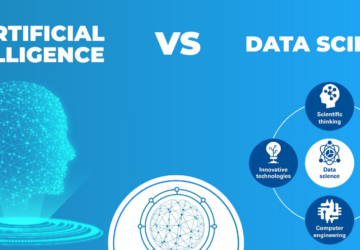The popularity of cloud computing is skyrocketing in demand as more business-focused cloud solutions are being released. The cloud has emerged to be a helping hand for businesses enabling them to focus their time and energy on building technology rather than just maintaining infrastructure. Nevertheless, as the cloud continues to grow, there will be a continuous innovation boom in the startup and small business landscape.
Cloud computing is a process where you receive computing resources as a service, which is managed by the cloud solutions provider rather than the end-user. The services encompass storage, databases, networking, software, analytics, and Intel cloud, all designed to provide adaptable resources, accelerate innovation, and leverage economies of scale. This differs from how earlier businesses used to operate by buying and managing their software and hardware.
Assuming that you have decided to adopt cloud computing for your business, the next step is knowing the difference and similarities between hybrid cloud and multi-cloud strategies and determining which approach is right for you. Since every organization has unique operational practices and workloads, finding the cloud environment that best suits your business needs is crucial.
Before we jump to the key differences between hybrid and multi-cloud strategies, let us understand each in detail.
What is hybrid cloud computing?
Hybrid cloud computing is a computing environment combining two or more types of clouds (public, private, or community) to perform various tasks. More than 80% of It leaders have adopted cloud computing. In this type of cloud computing environment, the organization can run applications and store data on its private cloud infrastructure while leveraging the resources of a public cloud when needed. For example, an organization may use a private cloud for their sensitive data and a public cloud for less sensitive data or for tasks that require more resources.
With a hybrid cloud, organizations can optimize their workloads, balance their resources, and reduce the costs of maintaining large private cloud infrastructure. However, managing a hybrid cloud environment can be complex and requires careful planning and integrating different cloud systems to ensure they work seamlessly together.
What is multi-cloud computing?
The organization uses multiple cloud computing services from different providers in a multi-cloud environment. Rather than relying on a single cloud service, multi-cloud computing allows organizations to distribute their workload across different cloud providers to achieve better flexibility, reliability, security, and cost-effectiveness.
Businesses can select different cloud services best suited to their needs in a multi-cloud environment. For example, an organization might use one cloud service to store data, another to run applications, and a third to manage its website. By using multiple cloud services, organizations can avoid vendor lock-in, reduce the risk of service interruptions, and take advantage of different pricing models to optimize their spending.
But it’s important to note that managing a multi-cloud environment can be complex. Organizations must ensure that data is secure and consistent across different services and that applications can communicate seamlessly across different clouds. To address these challenges, organizations can use specialized tools and services that help them monitor, manage, and automate their multi-cloud environment.

The Pros And Cons Of Multi-Cloud Computing
Pros of Multi-Cloud Computing
Below are some of the advantages of using multi-cloud computing for your business:
- Redundancy and Resilience:
Organizations can minimize the risk of downtime and service interruptions by leveraging multiple cloud services from different providers. In an outage or other issue with one cloud service, the organization can quickly switch to another service to ensure continuity of operations.
- Flexibility and Choice:
Multi-cloud services allow organizations to select the best services for their needs and requirements. For example, an organization may choose to use Amazon Web Services (AWS) for their data storage needs and Microsoft Azure for their application hosting needs.
- Cost Optimization:
With multi-cloud services, organizations can take advantage of competitive pricing and negotiate better rates with their cloud providers. This can help you in significant cost saving over a period of time.
Cons of Multi-Cloud Computing
Below are some of the challenges faced by companies while using multi-cloud computing:
- Complexity:
One of the primary drawbacks of multi-cloud computing is that it can be complex to manage. Managing multiple cloud services from different providers can be challenging and can require significant expertise and resources. This can lead to increased costs and operational overhead.
- Security Challenges:
While multi-cloud computing can improve an organization’s security posture, it can also introduce new security challenges. Managing security across multiple cloud services can be complex, and there is a risk of misconfiguration or human error that can lead to security breaches or data loss.
- Increased Latency:
Since data and applications are spread across multiple cloud services, additional network hops and latency may impact performance.

The Pros And Cons Of Hybrid-Cloud Computing
Pros of Hybrid Cloud Computing
Here we have listed some benefits of using a hybrid cloud environment:
- Flexibility and Scalability:
Hybrid cloud computing offers the ability to scale up or down based on the needs of the business. Companies can utilize the public cloud for high-demand periods while keeping sensitive data and critical applications in the private cloud. This means that companies can easily adjust to changing workloads without incurring high costs.
- Cost Savings:
Companies can reduce their infrastructure costs by leveraging the hybrid cloud for non-sensitive data and applications. The hybrid cloud offers a pay-as-you-go model, allowing companies to only pay for the needed resources. This reduces the need for companies to maintain large on-premise data centers, which can be costly to build and maintain.
- Improved Security:
Hybrid cloud computing allows companies to keep sensitive data and applications in a private cloud while utilizing the public cloud for non-sensitive data. This provides an additional layer of security, as the private cloud can be tightly controlled and monitored. Additionally, the hybrid cloud provider has robust security measures in place, providing another layer of protection.
Cons of Hybrid Cloud Computing
Here are some of the challenges faced by organizations while using a hybrid cloud environment:
- Complexity:
Hybrid cloud computing can be complex to set up and manage. Companies must ensure that their private cloud and public cloud environments are appropriately integrated and that the data and applications are synchronized. This requires significant technical expertise and can be challenging for smaller companies.
- Security Concerns:
Although hybrid cloud computing provides improved security, it also introduces new security concerns. Companies must ensure that their data and applications are appropriately secured in private and public cloud environments. Additionally, companies must ensure that their public cloud provider has adequate security measures.
- Cost:
While hybrid cloud computing can provide cost savings, it can also be costly to set up and maintain. Companies must have the resources and expertise to manage their hybrid cloud environment.
Key Differences between Hybrid Cloud and Multi-Cloud
- Infrastructure Management
A hybrid cloud requires businesses to manage both their on-premises and cloud-based infrastructure, which can be complex and time-consuming. On the other hand, multi-cloud requires businesses to manage multiple cloud providers, each with its own set of tools and services. This can create operational challenges and increase management complexity.
- Cost
A hybrid cloud can be more cost-effective than a multi-cloud, as it allows businesses to use their existing on-premises infrastructure and only pays for cloud-based services as needed. In contrast, multi-cloud can be more expensive, as businesses need to pay for each cloud provider separately.
- Security
Security is a critical consideration for any cloud deployment model. A hybrid cloud offers businesses more control over their data and infrastructure, as they can keep sensitive data on-premises and only move non-sensitive data to the cloud. This can help reduce the risk of data breaches and ensure compliance with industry regulations. Whereas multi-cloud requires businesses to trust multiple cloud providers with their data, which can increase the risk of security breaches.
Which cloud computing environment is right for your business?
The decision to go for a hybrid or multi-cloud approach largely depends on the location of your business’s non-cloud resources. Suppose your company has unique needs related to security or configuration that can be met by purchasing and operating an onsite private cloud. In that case, the hybrid route is the way to go. On the other hand, if an onsite private cloud is not essential or desirable, adopting a multi-cloud approach will provide similar benefits, such as disaster fortification, compliance management, and flexibility, but without the independence offered by a private cloud.
For small and mid-sized businesses, a multi-cloud approach typically offers the required flexibility and reliability without the complexity and infrastructure investment necessary for a hybrid cloud setup.
Simply put
The multi-cloud environment allows organizations to reap the benefits of large cloud providers’ scalability, flexibility, and cutting-edge technology. In contrast, the hybrid cloud empowers organizations with greater control over particular IT infrastructure components.
As per a report, around 89% of businesses use a multi-cloud strategy, while 80% employ a hybrid cloud strategy, combining private and public clouds. Before selecting the optimal cloud model for their enterprise, it is crucial for organizations to evaluate their cloud computing requirements meticulously.








